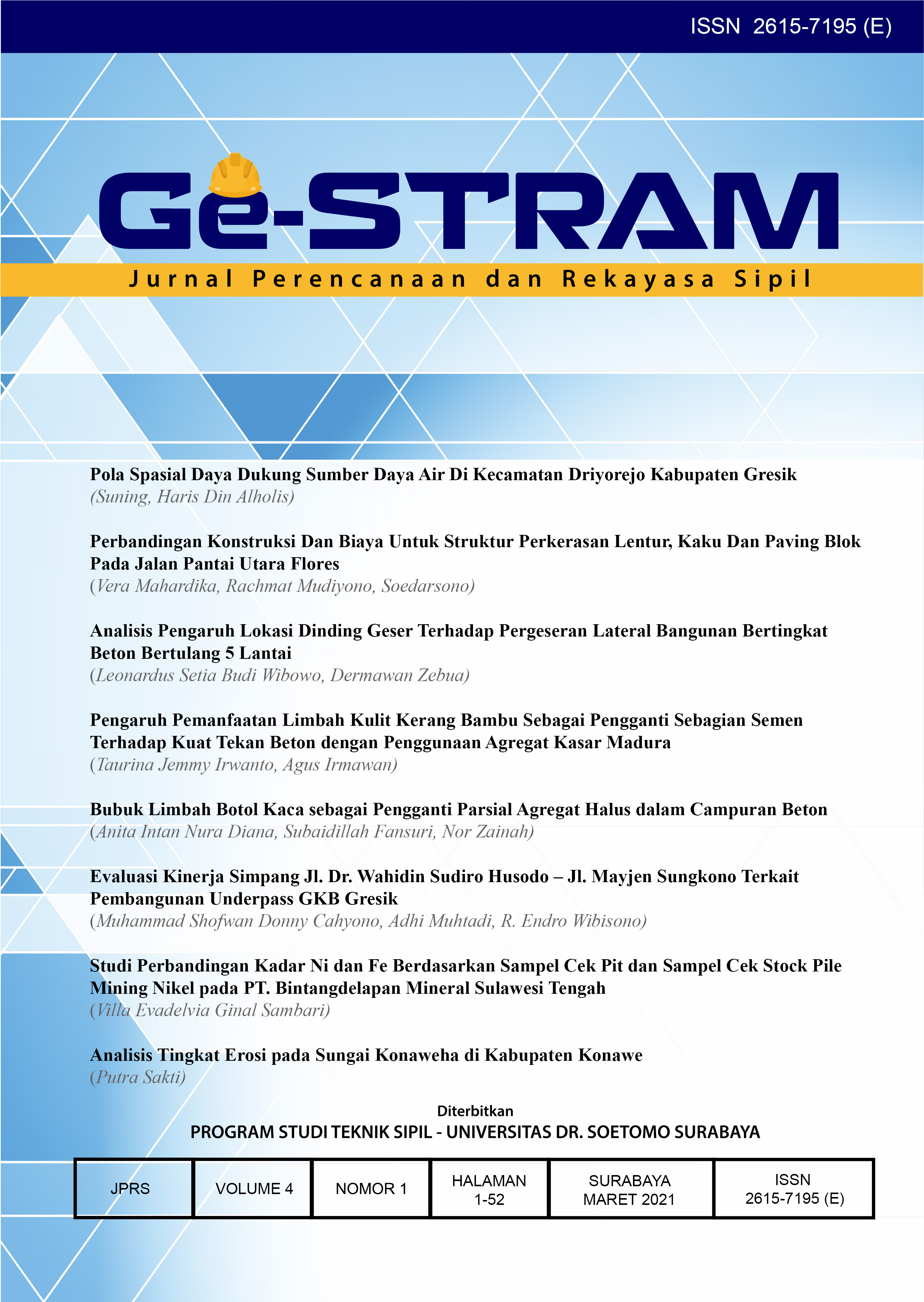Perbandingan Konstruksi Dan Biaya Untuk Struktur Perkerasan Lentur, Kaku Dan Paving Blok Pada Jalan Pantai Utara Flores
 Abstract views: 580
,
Abstract views: 580
,
 PDF downloads: 368
PDF downloads: 368
Abstract
Flexible, rigid, and paving block pavements can be used as alternative roads because the soil conditions on the Pantai Utara Flores road are rocky soil with a relatively high CBR so that the most important role in withstand load is subgrade. The purpose of the Comparison of Construction and Costs for Flexible, Rigid, and Paving Block Pavement Structures on Jalan Pantai Utara Flores is to know which one most effective and efficient when viewed from the traffic load with each pavement using the Bina Marga method, AASHTO , and Direktorat Jendral Bina Marga. Jalan Pantai Utara Flores is access to Komodo Labuan Bajo airport which is a Class I road, rocky land with a relatively high CBR, rainfall of Labuan Bajo is relatively low, LHR in Labuan Bajo is relatively small, besides Labuan Bajo is a tourist area that should be supported by road access that has driving comfort so the suitable pavement structure for Jalan Pantai Utara Flores is flexible pavement. Meanwhile, based on the recapitulation of the analysis results, the cost of flexible pavement is Rp. 28,793,604,705,600, the cost of a rigid pavement is Rp. 34,218,430,585,828 and the cost of paving block pavement is Rp. 17,410,645,080,000 so it can be seen that the paving block pavement is most economical, but the paving block pavement structure has a very uncomfortable driving comfort besides that the paving block pavement structure cannot be passed by vehicles at high speed so that the paving block pavement structure is more suitable for controlling speed of vehicles such as roads in crowded urban areas and residential roads.
References
Bina Marga. 2018. “Spesifikasi Umum 2018 untuk Pekerjaan Konstruksi Jalan dan Jembatan”. Jakarta: Direktorat Jenderal Bina Marga, Kementerian Pekerjaan Umum dan Perumahan Rakyat.
Bokko, J., dan Rangan, P.R. 2017. “Analisis Perbandingan Efisiensi Biaya Dan Metode Pelaksanaan Konstruksi Jalan Aspal Beton Dengan Rigid Beton”. Jurnal Dynamic Saint, Jilid III Nomor 01 Edisi Oktober 2017. Makale.
DP, Dian Arumningsih. 2012. “Perencanaan dan Estimasi Biaya Pada Proyek Pembangunan Jembatan Patihan Kabupaten Sragen”. Jurnal Teknik Sipil dan Arsitektur (JTSA), Volume 12 Nomor 16 Edisi 2012.
Kefie, P. Tinton, dkk. “Perancangan Perkerasan Concrete Blok dan Estimasi Biaya”. Skripsi S1 Universitas Kristen Petra, 2012.
Kompas. 2017.
Di Balik Kunjungan Sri Mulyani ke Labuan Bajo. https://ekonomi.kompas.com/read/2017/07/28/050000726/di-balik-kunjungan-sri-mulyani-ke-labuan-bajo-. Diakses 11 September 2020.
Maharani, A., dan Wasono, S.P. 2012. “Perbandingan Perkerasan Kaku Dan Perkerasan Lentur (Studi Kasus Ruas Jalan Raya Pantai Prigi-Popoh Kab. Tulungagung)”. Ge-STRAM : Jurnal Perencanaan dan Rekayasa Sipil, Volume 1 Nomor 02 Edisi September 2018. Surabaya.
Nurahmi, O., dan Kartika, A.A.G. 2012. “Perbandingan Konstruksi Perkerasan Lentur Dan Perkerasan Kaku Serta Analisis Ekonominya Pada Proyek Pembangunan Jalan Lingkar Mojoagung”. Jurnal Teknik ITS, Volume 1 Edisi September 2012. Surabaya.
PT. Floresco Aneka Indah. 2018. Penawaran Akses Bandara Komodo Labuan Bajo. Ruteng: PT. Floresco Aneka Indah.
Siyoto, S, dan Ali Sodik. 2015. Dasar Metodologi Penelitian. Yogyakarta : Literasi Media Publishing.
Copyright (c) 2021 Vera Mahardika

This work is licensed under a Creative Commons Attribution-ShareAlike 4.0 International License.
Authors who publish with this journal agree to the following terms:
- Authors retain copyright and grant the journal right of first publication with the work simultaneously licensed under a Creative Commons Attribution-ShareAlike 4.0 International License that allows others to share the work with an acknowledgement of the work's authorship and initial publication in this journal.
- Authors are able to enter into separate, additional contractual arrangements for the non-exclusive distribution of the journal's published version of the work (e.g., post it to an institutional repository or publish it in a book), with an acknowledgement of its initial publication in this journal.
- Authors are permitted and encouraged to post their work online (e.g., in institutional repositories or on their website) prior to and during the submission process, as it can lead to productive exchanges, as well as earlier and greater citation of published work (See The Effect of Open Access).

This work is licensed under a Creative Commons Attribution-ShareAlike 4.0 International License.















